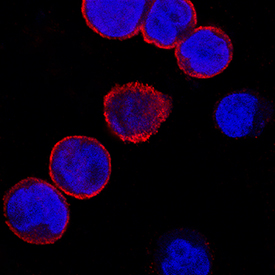Human Galectin-8 Antibody Summary
Met1-Trp317
Accession # O00214
Applications
Please Note: Optimal dilutions should be determined by each laboratory for each application. General Protocols are available in the Technical Information section on our website.
Scientific Data
 View Larger
View Larger
Galectin‑8 in U937 Human Cell Line. Galectin-8 was detected in immersion fixed U937 human histiocytic lymphoma cell line using Mouse Anti-Human Galectin-8 Monoclonal Antibody (Catalog # MAB13051) at 8 µg/mL for 3 hours at room temperature. Cells were stained using the NorthernLights™ 557-conjugated Anti-Mouse IgG Secondary Antibody (red; Catalog # NL007) and counterstained with DAPI (blue). Specific staining was localized to cell surfaces. View our protocol for Fluorescent ICC Staining of Cells on Coverslips.
Reconstitution Calculator
Preparation and Storage
- 12 months from date of receipt, -20 to -70 °C as supplied.
- 1 month, 2 to 8 °C under sterile conditions after reconstitution.
- 6 months, -20 to -70 °C under sterile conditions after reconstitution.
Background: Galectin-8
The galectins constitute a large family of carbohydrate-binding proteins with specificity for N-acetyl-lactosamine-containing glycoproteins. At least 14 mammalian galectins, which share structural similarities in their carbohydrate recognition domains (CRD), have been identified to date. The galectins have been classified into the prototype galectins (-1, -2, -5, -7, -10, -11, -13, -14), which contain one CRD and exist either as a monomer or a noncovalent homodimer. The chimera galectins (Galectin-3) containing one CRD linked to a nonlectin domain, and the tandem-repeat Galectins (-4, -6, -8, -9, -12) consisting of two CRDs joined by a linker peptide. Galectins lack a classical signal peptide and can be localized to the cytosolic compartments where they have intracellular functions. However, via one or more as yet unidentified non-classical secretory pathways, galectins can also be secreted to function extracellularly. Individual members of the galectin family have different tissue distribution profiles and exhibit subtle differences in their carbohydrate-binding specificities. Each family member may preferentially bind to a unique subset of cell-surface glycoproteins (1‑4).
Galectin-8, also known as prostate carcinoma tumor antigen 1 (PCTA1) in human, is a tandem repeat-type galectin. Prototype (single CRD) isoforms arising through alternate gene splicing have also been identified (5). Galectin-8 is highly expressed in lung carcinomas, certain forms of prostate carcinomas, as well as other tumor cells. It binds to a subset of cell surface integrins to modulate ECM-integrin interactions. As a soluble ligand, Galectin-8 can inhibit cell adhesion (6). Immobilized Galectin-8, however, has also been shown to promote cell adhesion (7). Human and mouse Galectin-8 share approximately 80% amino acid sequence identity (4).
- Rabinovich, A. et al. (2002) TRENDS in Immunol. 23:313.
- Rabinovich, A. et al. (2002) J. Leukocyte Biology 71:741.
- Hughes, R.C. (2002) Biochimie 83:667.
- R&D Systems’ Cytokine Bulletin, Summer, 2002.
- Bidon, N. et al. (2001) Gene 274:253.
- Hadari, Y. et al. (1995) J. Biol. Chem. 270:3447.
- Levy, Y. et al. (2001) J. Biol. Chem. 276:31285.
Product Datasheets
FAQs
No product specific FAQs exist for this product, however you may
View all Antibody FAQsReviews for Human Galectin-8 Antibody
There are currently no reviews for this product. Be the first to review Human Galectin-8 Antibody and earn rewards!
Have you used Human Galectin-8 Antibody?
Submit a review and receive an Amazon gift card.
$25/€18/£15/$25CAN/¥75 Yuan/¥2500 Yen for a review with an image
$10/€7/£6/$10 CAD/¥70 Yuan/¥1110 Yen for a review without an image

